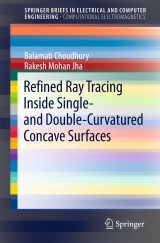Details

Refined Ray Tracing inside Single- and Double-Curvatured Concave Surfaces
SpringerBriefs in Electrical and Computer Engineering
|
53,49 € |
|
| Verlag: | Springer |
| Format: | |
| Veröffentl.: | 24.09.2015 |
| ISBN/EAN: | 9789812878083 |
| Sprache: | englisch |
Dieses eBook enthält ein Wasserzeichen.
Beschreibungen
This book describes the ray tracing effects inside different quadric surfaces. Analytical surface modeling is a priori requirement for electromagnetic (EM) analysis over aerospace platforms. Although numerically-specified surfaces and even non-uniform rational basis spline (NURBS) can be used for modeling such surfaces, for most practical EM applications, it is sufficient to model them as quadric surface patches and the hybrids thereof. It is therefore apparent that a vast majority of aerospace bodies can be conveniently modeled as combinations of simpler quadric surfaces, i.e. hybrid of quadric cylinders and quadric surfaces of revolutions. Hence the analysis of geometric ray tracing inside is prerequisite to analyzing the RF build-up. This book, describes the ray tracing effects inside different quadric surfaces such as right circular cylinder, general paraboloid of revolution (GPOR), GPOR frustum of different shaping parameters and the corresponding visualization of the ray-path details. Finally ray tracing inside a typical space module, which is a hybrid of a finite segment of right circular cylinder and a frustum of GPOR is analyzed for practical aerospace applications.
Introduction.- Modeling of Quadric Surfaces and Hybrids.- Refined Ray Tracing Technique.- Ray Propagation inside Quadric Surfaces and Hybrids.- Conclusion.
<div>Dr. Balamati Choudhury is currently working as a Scientist at Centre for Electromagnetics of CSIR-National Aerospace Laboratories, Bangalore, India since April 2008. She obtained her M.Tech. (ECE) degree in 2006 and Ph.D. (Engg.) degree in Microwave Engineering from Biju Patnaik University of Technology (BPUT), Rourkela, Orissa, India in 2013. During the period of 2006-2008, she was a Senior Lecturer in Department of Electronics and Communication at NIST, Orissa India. Her active areas of research interests are in the domain of soft computing techniques in electromagnetics, computational electromagnetics for aerospace applications and metamaterial design applications. She was also the recipient of the CSIR-NAL Young Scientist Award for the year 2013-2014 for her contribution in the area of Computational Electromagnetics for Aerospace Applications. She has authored or co-authored over 100 scientific research papers and technical reports including a book and three book chapters. Dr. Balamati is also an Assistant Professor of AcSIR, New Delhi. </div><div>Dr. Rakesh Mohan Jha was Chief Scientist & Head, Centre for Electromagnetics, CSIR-National Aero space Laboratories, Bangalore. Dr. Jha obtained a dual degree in BE (Hons.) EEE and MSc (Hons.) Physics from BITS, Pilani (Raj.) India, in 1982. He obtained his Ph.D. (Engg.) degree from Department of Aerospace Engineering of Indian Institute of Science, Bangalore in 1989, in the area of computational electromagnetics for aerospace applications. Dr. Jha was a SERC (UK) Visiting Post-Doctoral Research Fellow at University of Oxford, Department of Engineering Science in 1991. He worked as an Alexander von Humboldt Fellow at the Institute for High-Frequency Techniques and Electronics of the University of Karlsruhe, Germany (1992-1993, 1997). He was awarded the Sir C.V. Raman Award for Aerospace Engineering for the Year 1999. Dr. Jha was elected Fellow of INAE in 2010, for his contributions to the EM Applications to Aerospace Engineering. He was also the Fellow of IETE and Distinguished Fellow of ICCES. Dr. Jha has authored or co-authored several books, and more than five hundred scientific research papers and technical reports. He passed away during the production of this book of a cardiac arrest.</div>
<p>This book describes the ray tracing effects inside different quadric surfaces. Analytical surface modeling is a priori requirement for electromagnetic (EM) analysis over aerospace platforms. Although numerically-specified surfaces and even non-uniform rational basis spline (NURBS) can be used for modeling such surfaces, for most practical EM applications, it is sufficient to model them as quadric surface patches and the hybrids thereof. It is therefore apparent that a vast majority of aerospace bodies can be conveniently modeled as combinations of simpler quadric surfaces, i.e. hybrid of quadric cylinders and quadric surfaces of revolutions. Hence the analysis of geometric ray tracing inside is prerequisite to analyzing the RF build-up. This book, describes the ray tracing effects inside different quadric surfaces such as right circular cylinder, general paraboloid of revolution (GPOR), GPOR frustum of different shaping parameters and the corresponding visualization of the ray-path details. Finally ray tracing inside a typical space module, which is a hybrid of a finite segment of right circular cylinder and a frustum of GPOR is analyzed for practical aerospace applications.<br></p>
Presents the development of a novel algorithm Includes visualization of ray paths and curvature effects of various aerospace structures Covers analytical formulation of complex aerospace platform to reduce the computational burden Discusses high-frequency ray-tracing models for electrically large structures Includes supplementary material: sn.pub/extras
Diese Produkte könnten Sie auch interessieren:

Femtosecond Optical Frequency Comb: Principle, Operation and Applications

von: Jun Ye, Steven T. Cundiff

149,79 €















